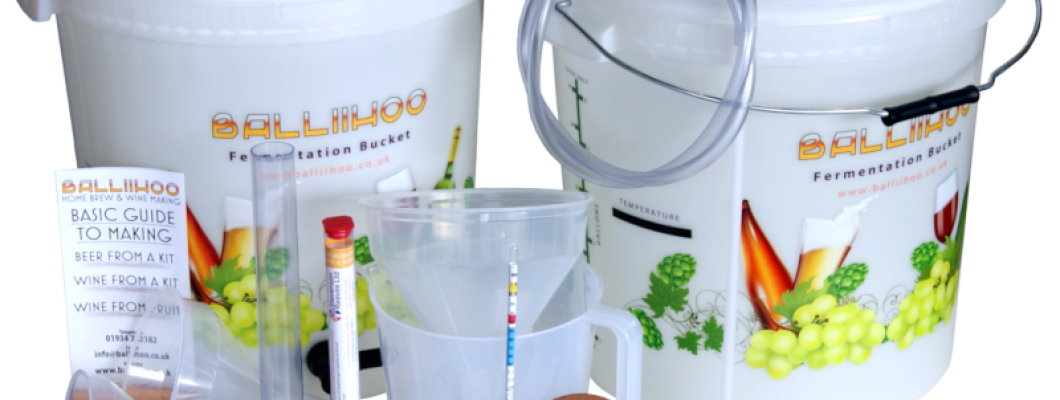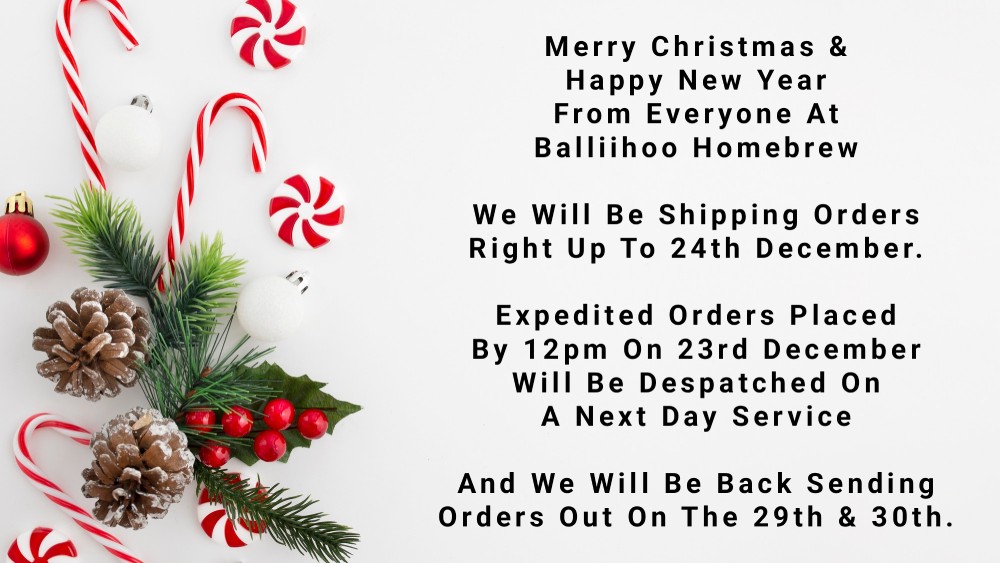A Basic Guide to Making Wine From An Ingredient Kit And Which Equipment Set Is Right For Me

A Basic Guide to Making Wine From An Ingredient Kit And Which Equipment Set Is Right For Me
Choosing An Equipment Set
Making Wine from a Kit can produce some delicious wines, which are not only satisfying but extremely cost-effective.
There are 2 different sizes of wine ingredient kits, those that make 6 bottles and those that make 30 bottles, then there are also 2 different types in terms of the time that they take until ready to drink, these are usually 7 day and 30 day (although some high end ingredient kits can take a little longer.
The variety available is huge, with several good brands and each brand having many different styles and types.
The first decision you will need to make is do i want to make 6 bottles at a time or 30 bottles (the equipment required is slightly different), think about how much room you have available and where you will keep you main fermentation vessel, this is an important factor as it will want to be somewhere fairly warm and may be in place for up to 30 days or more. When making wine you will need to transfer your fermented wine into a 2nd container (this is called racking off) and the 2nd container will need to be placed lower than the 1st.
Once your wine is finished, you will need to syphon it into a container to store and dispense, there are several options for this, so you may want to consider which is best for you. You can transfer into glass bottles or into a bag in a box type dispenser. There are 2 types of bottles in the UK cork and screw cap, so if you decide on the cork type you will require a corking tool. As screw tops are not readily available for screw type wine bottles, these are not generally sold by homebrew retailers……so if you decide to keep back and re-use your old screw cap bottles (which is absolutely safe as long as they are sterilised prior to use) it is important that you remember to keep the caps. The other option is bag in a box, these are cleverly designed bags, that fold in on themselves as the wine is dispensed (keeping your wine free from oxygen which is important), they are available is several different sizes, from 3 litre to 20 litre, one thing to consider if using bag in a box is that the larger sizes do not easily fit into a fridge, so if white wines are your thing you may want to go for the 3 or 5 litre sizes, whereas if you prefer reds, it will be perfectly fine to transfer almost an entire batch into 1 x 20 litre bag in a box as red wine is not generally chilled prior to drinking.
Choosing An Ingredient Kit
Once you have decided on your equipment for 6 0r 30 bottles you will want to choose a wine ingredient kit, there are several ranges and prices, which can seem a bit of a minefield, the price of any wine ingredient kit is usually based on the quality and volume of the grape juice concentrate that is included within it, the more quality juice the more expensive the kit will be, i would that if you are not making wine based entirely on budget then start mid range with VinClasse Black Box, On The House or Vineco Original Series. Some wine kits you see will appear very much cheaper than the mid range kits, but take a good look at the listings to see if they require sugar (Sugar will add alcohol content to you finished wine, but not body or flavour, so the can seem a little light) Whatever your budget and whichever wine kit you choose, they will all come with full easy to follow step by step instructions and if you are unclear about anything along the way, just give us a call or send us an email, we are happy to help.
Equipment Sets
Basic 6 Bottle Wine Making Sets
2 x 5 Litre Fermentation Buckets With Lids
Bubbler Airlock And Grommet
Temperature Strip
Plastic Spoon
Hydrometer And Trial Jar
Syphon Tube
Vinclasse 100g Steriliser
Large Plastic Jug
Funnels
(This Equipment Set Is Available With A Choice Of Ingredient Kits)
Basic 30 Bottle Wine Making Sets
All The Equipment Above But With 30 Litre Buckets Plus
Racking Cane
Leather Coaster
This Set Is Available On Its Own Or With A Choice Of Ingredient Kits)
Premium 30 Bottle Wine Making Set
All The Equipment Above But With
Upgrade To An Auto Syphon
Twin Lever Bottle Corker
30 Wine Corks
Heater Belt
Wine Bottle Labels
Wine Bottle Shrinks
This Set Is Available On Its Own Or With A Beaverdale 30 Bottle Chardonnay Or Cabernet Sauvignon Ingredient Kit
Every wine ingredient kit will come supplied with step by step instructions that are specific to each kit and should always be followed, below is an outline guide of what you can expect.
Step 1: Cleaning
Arguably the most essential part of winemaking: it’s important to clean and sterilise all equipment that will come into contact with the brew, as fermenting wine is an ideal breeding ground for bacteria which, if it takes hold, will ruin your finished wine.
There are three main types of Sterilisers:
Chlorine Based (VinClasse Cleaner Steriliser and VWP are both examples of this)
Sodium Percarbonate (A very gentle ‘No-Rinse Cleaner’, not dissimilar to the steriliser used for cleaning baby bottles)
Sodium Metabisulphite (A very harsh steriliser traditionally used in winemaking, but not the author’s recommendation)
Follow the instructions on the steriliser packaging closely: make up the sterilising solution and pour it into your fermentation bucket.
Place all other equipment inside and wash thoroughly, then leave to soak for a short time before draining the solution out of the bucket and carefully rinsing all equipment. (Rinsing is not necessary with Sodium Percarbonate, but the author recommends this as it can leave a slightly chalky residue)
Step 2: Preparing the Wine Kit
Pour the grape juice concentrate into the bucket.
Add the required amount of brewing sugar (if needed)
Top up with cold and hot water to the desired level (stated in our ingredient kit) to achieve a specific temperature between 18°C and 22°C (this may vary with each ingredient kit). Stir well.
3. Checking the Gravity
The Hydrometer is an important piece of equipment which enables the winemaker to not only check the alcoholic content of their product but can also enable the winemaker to track the progress of fermentation.
Check the original gravity of the brew using the hydrometer by floating it in a sample and reading off the level. (Ignore the decimal point and read it as 990, 1000, 1010, 1020 etc.). Most wine kits will read approximately 1080 at this stage.
Write the gravity level down and label it as your ‘original gravity’ You will want this reading for later in the process!
4. Fermentation
Add the sachets of wine yeast and yeast nutrient as directed and fit the lid tightly to the bucket and insert the airlock bubbler into the hole in the lid (add a little water into the airlock bubbler)
Fermentation usually only can take place between 18°C and 26°C so please keep in a warm place until fermentation is complete.
A lack of bubbles on the surface of your wine may indicate that the fermentation has been completed, or two unchanged hydrometer readings over two consecutive days. When Fermentation is complete, the wine will be ready for bottling.
The final gravity reading should be around 998 or below. Write down the Final Gravity Reading.
5. Racking off
Rack off (syphon off) into another sterilised and rinsed bucket, leaving behind the sediment (don’t worry if a little goes over).
Add the stabiliser sachet (also known as fermentation stopper) and stir in well.
6. Finings
Add the finings as directed. This will clear your wine.
(Most wine kits have ‘two-part’ finings - which requires you to leave 24 hours between adding each part).
Leave for a couple of days.
7. Bottling
Once your wine is clear, you are ready to bottle (or you may use a ‘bag in a box’). You can syphon directly into each sterilised bottle, or into a large sterilised jug from which you can then fill your bottles. If your fermentation bucket has a tap, you can use that.
Fill your bottles to leave approximately a 1-inch gap between the wine and the bottom of the cork.

